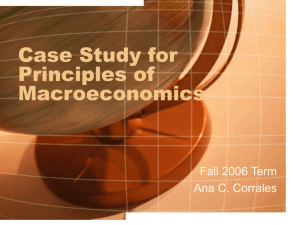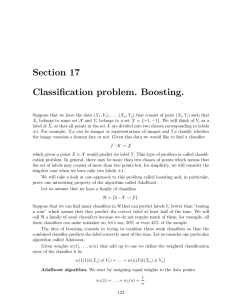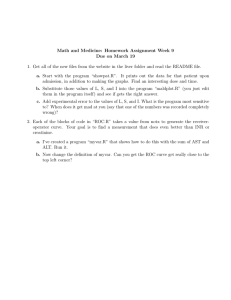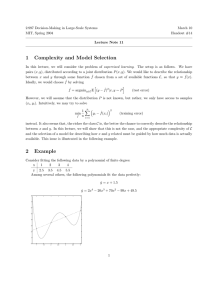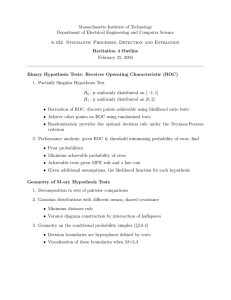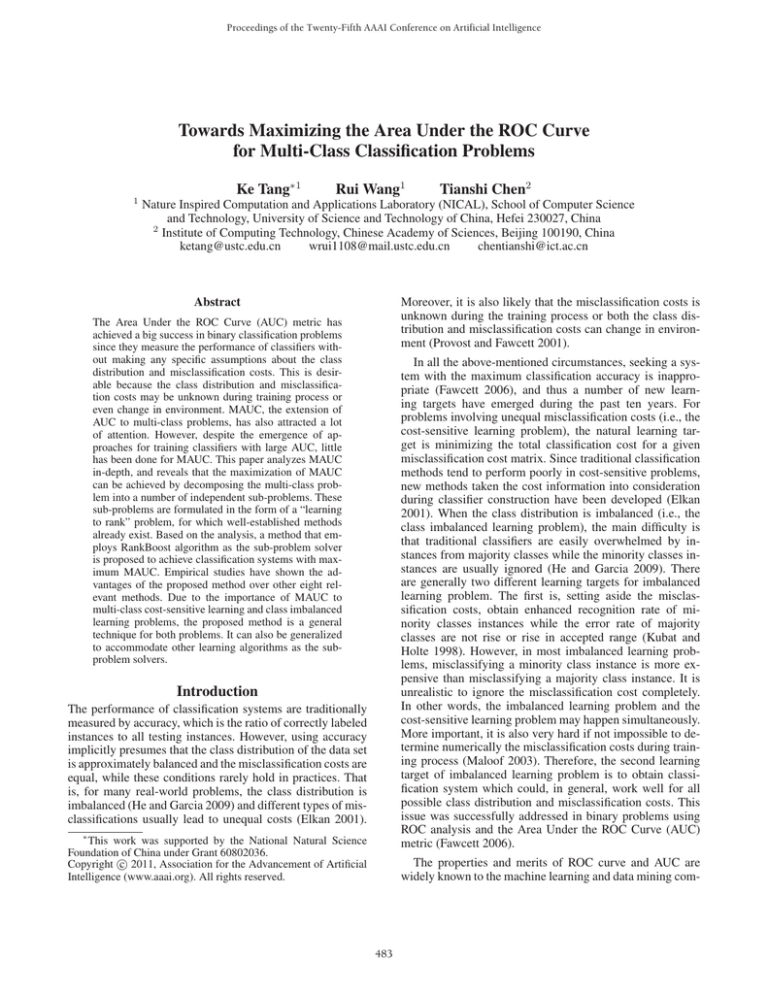
Proceedings of the Twenty-Fifth AAAI Conference on Artificial Intelligence
Towards Maximizing the Area Under the ROC Curve
for Multi-Class Classification Problems
1
Ke Tang∗1
Rui Wang1
Tianshi Chen2
Nature Inspired Computation and Applications Laboratory (NICAL), School of Computer Science
and Technology, University of Science and Technology of China, Hefei 230027, China
2
Institute of Computing Technology, Chinese Academy of Sciences, Beijing 100190, China
ketang@ustc.edu.cn
wrui1108@mail.ustc.edu.cn
chentianshi@ict.ac.cn
Moreover, it is also likely that the misclassification costs is
unknown during the training process or both the class distribution and misclassification costs can change in environment (Provost and Fawcett 2001).
Abstract
The Area Under the ROC Curve (AUC) metric has
achieved a big success in binary classification problems
since they measure the performance of classifiers without making any specific assumptions about the class
distribution and misclassification costs. This is desirable because the class distribution and misclassification costs may be unknown during training process or
even change in environment. MAUC, the extension of
AUC to multi-class problems, has also attracted a lot
of attention. However, despite the emergence of approaches for training classifiers with large AUC, little
has been done for MAUC. This paper analyzes MAUC
in-depth, and reveals that the maximization of MAUC
can be achieved by decomposing the multi-class problem into a number of independent sub-problems. These
sub-problems are formulated in the form of a “learning
to rank” problem, for which well-established methods
already exist. Based on the analysis, a method that employs RankBoost algorithm as the sub-problem solver
is proposed to achieve classification systems with maximum MAUC. Empirical studies have shown the advantages of the proposed method over other eight relevant methods. Due to the importance of MAUC to
multi-class cost-sensitive learning and class imbalanced
learning problems, the proposed method is a general
technique for both problems. It can also be generalized
to accommodate other learning algorithms as the subproblem solvers.
In all the above-mentioned circumstances, seeking a system with the maximum classification accuracy is inappropriate (Fawcett 2006), and thus a number of new learning targets have emerged during the past ten years. For
problems involving unequal misclassification costs (i.e., the
cost-sensitive learning problem), the natural learning target is minimizing the total classification cost for a given
misclassification cost matrix. Since traditional classification
methods tend to perform poorly in cost-sensitive problems,
new methods taken the cost information into consideration
during classifier construction have been developed (Elkan
2001). When the class distribution is imbalanced (i.e., the
class imbalanced learning problem), the main difficulty is
that traditional classifiers are easily overwhelmed by instances from majority classes while the minority classes instances are usually ignored (He and Garcia 2009). There
are generally two different learning targets for imbalanced
learning problem. The first is, setting aside the misclassification costs, obtain enhanced recognition rate of minority classes instances while the error rate of majority
classes are not rise or rise in accepted range (Kubat and
Holte 1998). However, in most imbalanced learning problems, misclassifying a minority class instance is more expensive than misclassifying a majority class instance. It is
unrealistic to ignore the misclassification cost completely.
In other words, the imbalanced learning problem and the
cost-sensitive learning problem may happen simultaneously.
More important, it is also very hard if not impossible to determine numerically the misclassification costs during training process (Maloof 2003). Therefore, the second learning
target of imbalanced learning problem is to obtain classification system which could, in general, work well for all
possible class distribution and misclassification costs. This
issue was successfully addressed in binary problems using
ROC analysis and the Area Under the ROC Curve (AUC)
metric (Fawcett 2006).
Introduction
The performance of classification systems are traditionally
measured by accuracy, which is the ratio of correctly labeled
instances to all testing instances. However, using accuracy
implicitly presumes that the class distribution of the data set
is approximately balanced and the misclassification costs are
equal, while these conditions rarely hold in practices. That
is, for many real-world problems, the class distribution is
imbalanced (He and Garcia 2009) and different types of misclassifications usually lead to unequal costs (Elkan 2001).
∗
This work was supported by the National Natural Science
Foundation of China under Grant 60802036.
c 2011, Association for the Advancement of Artificial
Copyright Intelligence (www.aaai.org). All rights reserved.
The properties and merits of ROC curve and AUC are
widely known to the machine learning and data mining com-
483
munities (Fawcett 2006; Huang and Ling 2005). Generally
speaking, a ROC curve explicitly shows the tradeoff between the true positive rate and the false positive rate of
a binary classification system on different operating points,
putting the class distribution and the misclassification costs
out of the evaluation of classifiers’ performance. Once the
class distribution and misclassification cost matrix are given,
a categorical classifier with the least total cost can be determined by threshold moving (Lachiche and Flach 2003).
However, it is commonly the case that the ROC curves of
two classifiers cross over at some point in the ROC space,
and thus ROC curve is not a suitable approach for identifying the best classifier in practice. Alternatively, a standard
metric used by researchers to indicate the quality of ROC
curve is AUC (Fawcett 2006). Larger AUC corresponds to
good ROC curve and implies, in general, the classifier can
achieve smaller total cost by moving the threshold given a
specific class distribution and misclassification cost matrix.
The extension of ROC curve to multi-class problem is the
ROC hyper-surface, which inherits all the desirable properties of ROC curve. For example, it has been shown that
a classifier with good ROC hyper-surface can lead to classifiers suitable for various class distribution and misclassification costs via simple re-optimization the its output matrix (Srinivasan 1999; Bourke et al. 2008). However, it is,
again, unlikely that the ROC hyper-surface of a classifier
covers that of another classifier entirely. Furthermore, due
to the increase of the dimensionality of the ROC space,
achieving the optimal ROC hyper-surface is even more difficult than achieving the optimal ROC curve. Hence, researchers have extended the AUC to multi-class problem
to establish tractable learning targets and to facilitate the
comparison between classifiers. A straightforward generalization of AUC is the Volume Under the ROC hyperSurface (VUS) (Ferri, Hernández-orallo, and Salido 2003),
but the computation of VUS is complicated and elusive
(Landgrebe and Duin 2008). Moreover, (Edwards, Metz, and
Nishikawa 2005) has pointed it out theoretically that the
VUS value of a “near guessing” classifier will get close
to a “near perfect” classifier when the number of class
c > 2. Therefore, a simpler generalization of AUC for
multi-class problems, namely MAUC (Hand 2001), has been
much more widely used in recent work (Zhou and Liu 2006;
Cerquides and Mantaras 2005; Sikonja 2004).
During the past decade, a number approaches have been
developed to directly train classifiers with large AUC (Ferri,
Flach, and Hernandez-Orallo 2002; Herschtal and Raskutti
2004; Yan et al. 2003). However, few of them can be easily
extended to multi-class problem. In fact, research on related
topics such as imbalanced learning problems is also highly
focused on binary class problem, while progress on multiclass problems is limited (He and Garcia 2009). For those related work on multi-class problems, MAUC was merely employed as the core indicator (sometimes the only indicator)
for evaluating the performance of a classifier, but not as the
learning target. To the best of our knowledge, the only work
that explicitly aims to seek classifiers with large MAUC appeared very recently, namely Evolutionary AUC Maximization (EAM) (Lu, Ke, and Yao 2010). EAM employs an evo-
lutionary algorithm to search for the optimal weights for a
neural network, so that the MAUC of the neural network is
maximized. The computational cost of EAM is reported to
be high while the performance in terms of MAUC is mixed,
as will be shown by our experimental study. In this work,
we explore how to obtain maximum MAUC and propose a
method named MAUC Decomposition based Classification
method (MDC). Briefly speaking, our analysis of MAUC
revealed that the maximization of MAUC can be decomposed in to a batch of independent sub-problems. Each subproblem can be formulated in such a way that an existing
technique, the RankBoost algorithm (Freund et al. 2003),
can solve it nicely. Hence, the MDC method first decomposes the MAUC into sub-problems. Then the RankBoost
algorithm is employed to solve each sub-problem independently. Finally, classifiers obtained on all sub-problems are
combined together to form the final classification system.
Extensive empirical studies have been carried out to compare MDC with other 8 relevant methods, and the results
clearly demonstrate the advantages of MDC.
The rest of the paper starts with the analysis of MAUC.
Then, the MDC method is described in detail in Section 3.
In Section 4, experimental studies are presented, followed
by the conclusions in Section 5.
Analysis of MAUC
MAUC: A Multi-class Extension of AUC
Given
a
set
of
instances
S
=
{(x1 , y1 ), (x2 , y2 ), . . . , (xn , yn )}, where xi ∈ Rm is
the feature vector of the i-th instance, and yi ∈ {0, 1}
is the label of the i-th instance. A classifier H(xi ) → R
output a numerical score1 that indicates the confidence of
xi belonging to class 0. The AUC of this classifier can be
calculated by,
xi ∈class(0); xj ∈class(1) s(xi , xj )
AUC =
(1)
n0 × n1
where n0 and n1 denote the number of instances in class 0
and class 1 respectively, and s(xi , xj ) is defined as:
1,
if H(xi ) > H(xj );
0.5, if H(xi ) = H(xj );
(2)
s(xi , xj ) =
0,
if H(xi ) < H(xj ).
For multi-class problems (i.e., yi ∈ {1, . . . , c}), a classifier will provide a n×c matrix M . The element mij indicates
the confidence that the i-th instance in S belongs to class j.
The MAUC is defined as,
Aij + Aji
2
(3)
MAUC =
c × (c − 1) i<j
2
where Aij is the AUC between class i and class j calculated
from the i-th column of M . Note that for multi-class problems, Aij may not equal to Aji , and thus both of them need
to be involved in the calculation of MAUC (Hand 2001).
1
Although some types of classifiers were originally designed to
output the class label directly, most of them have been extended to
produce numerical scores. One typical example is the probabilistic
decision tree (Provost and Domingos 2003).
484
The MDC Method
Decomposition of MAUC
For the sub-problem defined by Eq. (6), a classifier needs to
be trained so that the instances from class i is ranked above
instances from the other classes. If an instance x from class
i is ranked above (i.e., having larger score than) an instance
1
from class j, the classifier will get a reward of (c−1)×n
i ×nj .
Assuming that the scores of two different instances are also
different, Eq. (6) can be further presented in the following
form:
D(x, x )[[H(x) > H(x )]]
(7)
max
Suppose that a multi-class problem is decomposed into
c×(c−1)
binary sub-problems in the one-versus-one manner.
2
Each sub-problem involves two of the c classes. It can be
observed from Eq. (3) that MAUC is actually the average of
the AUC values of all the binary sub-problems. Each AUC
value in this case is calculated twice for corresponding subproblem, based on two columns of the matrix M . Hence,
maximizing MAUC involves adjusting the columns of M
inter-dependently, which is very difficult.
Fortunately, the MAUC can also be analyzed in a different
way by re-writing Eq. (3) as Eq. (4),
MAUC =
c
c
1 1
Aij
c i=1 c − 1
x;x
x is an instance in class i, x is an instance in class j (j =
i). [[H(x) > H(x )]] equals to 1 (0) when H(x) > H(x )
is true (false). D(x, x ) is the reward for the two instances
being ranked correctly, which is
1
(8)
D(x, x ) =
(c − 1) × ni × nj
By summing up the D(x, x ) of all pairs of x and x , we
have
D(x, x ) = 1
(9)
(4)
j=1;j=i
From Eq. (4), it can be observed that MAUC can be regarded
as the average of Eq. (5) over all columns of M .
Ai =
1
c−1
c
Aij .
(5)
j=1;j=i
x;x
Hence, MAUC can be maximized as long as each Ai (1 ≤
i ≤ c) in Eq. (5) is maximized. Note that each Ai is calculated solely based on the i-th column of M . Thus, the optimization of different Ai is not necessarily inter-dependent
and can be done separately. Having this observation in mind,
we may obtain another implication for building classification systems with maximum MAUC. To be specific, many
classification techniques, such as neural network, Naive
Bayes and decision tree, are capable of providing the matrix M in a single run. This is a desirable property in many
cases. However, in the context of MAUC, training classifiers
in this way means optimizing all Ai as a whole (i.e., make
the optimization of Ai dependent with one another), and increase the difficulty of obtaining a good classifier. Instead, it
may be much easier to train c classifiers (following the formulation given in Eqs. (4) and (5)), each of which only aims
to achieve one maximum Ai . The ensemble of these classifiers will serve as the final classification system that provides
a desirable MAUC value.
According to the above analysis, we propose to seek a
classification system with large MAUC by solving for each
class i the following sub-problem:
1
max Ai =
c−1
=
=
1
c−1
c
Aij
j=1;j=i
c
j=1;j=i
1
1
×
c − 1 ni
Eq. (7) is in the form of a typical “learning to rank” problem. Moreover, with the additional condition given in Eq.
(8), the problem is actually the “bipartite feedback” problem investigated in a previous work (Freund et al. 2003), and
can be nicely addressed by the RankBoost algorithm proposed therein. RankBoost is a boosting type algorithm which
works by combining a batch of weak learners. In each iteration, a weak classifier is trained. Over the iterations, the focus will be concentrated on the pairs of instances that are difficult to rank correctly. Specifically, the RankBoost.B algorithm (Freund et al. 2003) fit our problem perfectly. Therefore, it is directly employed in this work as the sub-problem
solver and decision stump is employed as the weak learner.
The only modification we made to the RankBoost.B algorithm is the initial weights assigned to each instance, which
is determined using Eq. (8). Readers are referred to the original publication of the RankBoost algorithm for its implementation details.
By now, all details of the proposed MDC method have
been presented. To summarize, MDC first decompose a
multi-class problem into c sub-problems. Then, RankBoost.B algorithm is applied to solve the sub-problems separately. After that, the final classification system is composed
of the classifiers trained for all sub-problems. The pseudocode of the MDC method is presented in Algorithm 1.
x∈class(i);
x ∈class(j)
c
j=1;j=i
1
nj
s(x, x )
ni × nj
Experiments
Data Sets
s(x, x )
16 data sets were used in our experiments, 14 of them (except phoneme data set and washington data set) are from
UCI Machine Learning Repository (Asuncion and Newman
2007), washington data set is hyperspectral imaginary data
set (Neher and Srivastava 2005), and phoneme (Hastie, Tibshirani, and Friedman 2001) data set is from handwritten
digits recognition problem. Information of these data sets
are summarized in Table 1.
(6)
x∈class(i);
x ∈class(j)
where ni and nj are number of instances in class i and class
j respectively, s(x, x ) is defined the same as Eq. (2).
485
Algorithm 1 Pseudo-code of MDC
Input: data set consist of c classes
for i = 1 to c do
Table 1: Summary of the data sets used in the experiments
Data set
abalone
arrhythmia
if x ∈ class(i);
contraceptive
v1 (x) =
glass
if x ∈ class(j); j = i.
hayes-roth
isolet
for t = 1 to T do
mfeat
train weak learner ht using distribution D(x, x ) =
page-blocks
vt (x) × vt (x )
phoneme
choose αt ∈ R
shuttle
splice
update:
thyroid-allhypo
thyroid-allrep
v (x) exp(−α h (x))
t
t t
washington
, if x ∈ class(i);
Zt
waveform40
vt+1 (x) =
vt (x) exp(αt ht (x))
,
if x ∈ class(j); j =
i. yeast
Z
1
(c−1)×ni ,
1
nj ,
t
where:
Zt = x∈class(i) vt (x) exp(−αt ht (x))
Zt = x∈class(i)
vt (x) exp(αt ht (x))
/
end for T
Hi (x) = t=1 αt ht (x)
end for
H = {H1 , H2 , . . . , Hc }
No. of features
No. of instances
No. of classes
8
279
9
9
3
617
649
10
256
9
60
28
28
210
40
8
4139
416
1473
192
160
7797
2000
5473
4509
57977
3190
3770
3772
11200
5000
1479
18
7
3
4
3
26
10
5
5
5
3
3
4
7
3
9
range of c is 2−5 , 2−3 , . . . , 215 , and the search range of γ
is 2−15 , 2−13 , . . . , 23 . The generation number of EAM was
set to 500, and all the other parameters were set according
to the original publication. For each data set, 20 times 5fold cross-validation were performed. The average MAUC
of each method on every data set is reported in Table 2.
To check whether the differences between MDC and other
methods are significant, Wilcoxon signed rank statistical test
with 95% confidence level has been conducted. The results
of these statistical tests is also given in Table 2. Besides, the
best average MAUC value on each data set was highlighted
in boldface.
Experimental setup
We compared MDC with other 8 classification methods:
Rescale (Zhou and Liu 2006), Multi-class RankBoost, EAM
(Lu, Ke, and Yao 2010) , Naive Bayes, 1-Nearest Neighbor
(1NN), C4.5, Artificial Neural Network (ANN), and Support Vector Machines (SVM) with RBF kernel. Rescale is an
instances weighting method (using C4.5 as the base classifier) which was designed for multi-class cost-sensitive learning and imbalanced learning. It has been reported to be capable of achieving large MAUC on multi-class problems.
Since MDC employs RankBoost as the sub-problem solver,
it is interesting to examine whether RankBoost can be directly extended to maximize MAUC. Hence, we modified
the RankBoost, which was originally designed for binary
class problems, to a multi-class version and obtained the
Multi-class RankBoost algorithm (we call it M-RankBoost
hereafter). The extension is implemented by decomposing
the multi-class problem into a number of binary class problems in one-versus-all manner. As mentioned before, EAM
might be the first attempt that explicitly seeks classifiers with
large MAUC, thus it is included into the experiments. The
remaining 5 methods are all mainstream machine learning
techniques. They not only provide a baseline for the empirical studies, but may also tell whether designing a specific
approach with respect to MAUC is worthwhile.
All the compared methods were implemented on WEKA
(Witten and Frank 2000) platform. The number of weak
learners was set to 50 for both MDC and M-RankBoost. The
parameter c and γ of SVM were set to be the values which
maximize the average MAUC in a 3-fold cross-validation on
the training data set of a 5-fold cross-validation. The search
Results
From Table 2, it can be observed that MDC achieved the best
results on 12 out of 16 data sets. The advantage of MDC
over all the other 8 compared methods is statistically significant on 8 data sets. Concretely, MDC performed significantly worse than ANN on the abalone, isolet and waveform40 data sets, and was outperformed by EAM on the
waveform40 data set. Besides, MDC is significantly better
than Rescale, 1NN, Naive Bayes, C4.5 and SVM on almost all data sets, with merely two exceptions for comparisons with Rescale and C4.5 (where the difference of MDC
and the compared method is insignificant), respectively. MRankBoost was significantly outperformed by MDC on 11
data sets. On the remaining 5 data sets, difference between
the two methods is insignificant. To summarize, MDC overall performed the best among all the 9 methods involved in
the experiments. The superiority of MDC to M-RankBoost
showed that the proposed MAUC decomposition strategy is
crucial to the appealing performance of MDC, since it is the
only difference between MDC and M-RankBoost. As a recently proposed method, EAM did not show good performance in the experiment. One possible reason might be that
the generation number was set too small to make EAM converge to good solutions. However, as can be found in Table
3, the runtime of EAM is the longest, and is at least ten times
longer than that of MDC in the current setting. Hence, we
feel it impractical to evaluate EAM with a larger generation
486
Table 2: The MAUC achieved by the 9 compared methods. The MAUC value of each method is averaged over 20 independent
runs of 5-fold cross-validation. For each data set, Wilcoxon signed-rank test with 95% confidence level is employed to compare
the 8 other methods with MDC. The methods that performed significantly worse (better) than MDC is highlighted with †(‡).
The largest MAUC on each data set is in boldface.
abalone
arrhythmia
contraceptive
glass
hayes-roth
isolet
mfeat
page-blocks
phoneme
shuttle
splice
thyroid-allhypo
thyroid-allrep
washington
waveform40
yeast
MDC
Rescale
M-RankBoost
EAM
Naive Bayes
1NN
C4.5
SVM
ANN
0.7847
0.8623
0.7311
0.8868
0.9564
0.9955
0.9979
0.9869
0.9853
0.9998
0.9869
0.9983
0.9622
0.9855
0.9583
0.8547
0.7361†
0.7539†
0.6434†
0.7837†
0.9515
0.9265†
0.9710†
0.9343†
0.9333†
0.9998†
0.9561†
0.9905†
0.9382†
0.9314†
0.8283†
0.7492†
0.7773†
0.8541†
0.7280†
0.8853
0.9391†
0.9955
0.9979
0.9758†
0.9852†
0.9995†
0.9866†
0.9971†
0.9563†
0.9855
0.9583
0.8340†
0.7491†
0.7262†
0.7090†
0.8157†
0.8633†
0.8802†
0.8430†
0.9458†
0.9294†
0.9250†
0.8930†
0.9629†
0.8309†
0.9070†
0.9669‡
0.8523
0.7564†
0.8144†
0.6876†
0.8130†
0.9059†
0.9840†
0.9904†
0.9503†
0.9737†
0.9655†
0.9749†
0.9274†
0.9126†
0.9662†
0.9562†
0.8539
0.5486†
0.6452†
0.5603†
0.7659†
0.9077†
0.9422†
0.9885†
0.8490†
0.9206†
0.9830†
0.7509†
0.7003†
0.6612†
0.8857†
0.8003†
0.7064†
0.5972†
0.7675†
0.6597†
0.7924†
0.9494
0.9264†
0.9710†
0.9386†
0.9264†
0.9958†
0.9410†
0.9893†
0.9182†
0.9314†
0.8299†
0.7420†
0.5632†
0.7465†
0.6427†
0.7491†
0.8979†
0.9858†
0.9844†
0.7884†
0.9510†
0.9883†
0.8940†
0.8826†
0.8214†
0.9452†
0.9006†
0.7280†
0.7978‡
0.8404†
0.7149†
0.8344†
0.8317†
0.9983‡
0.9978
0.9161†
0.9838†
0.9011†
0.9550†
0.9094†
0.9053†
0.9011†
0.9625‡
0.8229†
number.
Table 3 summarizes the runtime of the compared methods. It can be observed that MDC is computationally less
expensive than ANN and EAM. The runtime of it is comparable to that of M-RankBoost and SVM , while is much
longer than that of Rescale, Naive Bayes, 1NN and C4.5.
ROC curve (Provost and Fawcett 2001). To achieve this, a
technique is required to be capable of exploring classifiers
that perform well in different region of the ROC space, as
done in a recent work (Fawcett 2008). However, such work
is still restricted to binary class problems, while extension to
multi-class problems is never a trivial task. For multi-class
problems, one potential approach for generating a good ensemble of classifiers is to seek classifiers with large MAUC,
while exhibit diverse characteristics in the ROC space. The
method proposed in this paper plays an important role in
such an approach, and the remaining issues will be investigated in the future.
Conclusions
For multi-class classification problem, a classifier with large
MAUC can be easily adapted to various scenarios in which
the class distribution is imbalanced and/or misclassification
costs is unequal, and to the situations that the class distribution and misclassification costs change over time. Therefore,
MAUC is an important intermediate learning target for tackling real-world problems in uncertain environments. In spite
of this, few techniques have been developed for maximizing
the MAUC of a classification system. This paper analyzes
the MAUC and shows that MAUC can be decomposed to facilitate the maximization of MAUC. Based on the analysis,
a novel method is proposed to build classification systems
with maximum MAUC. It is shown that the proposed MDC
method outperformed a number of traditional mainstream
machine learning techniques as well as recent methods that
were claimed to favor MAUC. Since large MAUC is desirable in the context of class imbalanced learning and costsensitive learning, the proposed method is a general technique that is applicable to both types of problems. Furthermore, the analysis of MAUC is applicable for any type of
learning algorithms that are capable of handling the subproblem defined in Eq. (5). Therefore, although RankBoost
algorithm is adopted in this work, the MDC method can easily accommodate other learning algorithms as well.
For the above-mentioned uncertain environments, it has
been shown that the integration of multiple ROC curves (i.e.,
multiple classifiers) can be more robust than using a single
References
Asuncion, A., and Newman, D.
2007.
UCI
machine
learning
repository.
http://www.ics.uci.edu/∼mlearn/MLRepository.html.
Bourke, C.; Deng, K.; Scott, S. D.; and Vinodchandran, R.
E. S. N. V. 2008. On reoptimizing multi-class classifiers.
Machine Learning 71(2-3):219–242.
Cerquides, J., and Mantaras, R. L. D. 2005. Robust Bayesian
linear classifier ensembles. In Proceedings of 16th European
Conference on Machine Learning, 72–83.
Edwards, D. C.; Metz, C. E.; and Nishikawa, R. M. 2005.
The hypervolume under the ROC hypersurface of ”nearguessing” and ”near-perfect” observers in N-class classification tasks. IEEE transactions on medical imaging
24(3):293–239.
Elkan, C. 2001. The Foundations of Cost-Sensitive Learning. In Proceedings of 17th International Joint Conference
on Artificial Intelligence, 973–978.
Fawcett, T. 2006. An introduction to ROC analysis. Pattern
Recognition Letters 27:861–874.
487
Table 3: Average runtime (in seconds) of the compared methods on the 16 data sets.
abalone
arrhythmia
contraceptive
glass
hayes-roth
isolet
mfeat
page-blocks
phoneme
shuttle
splice
thyroid-allhypo
thyroid-allrep
washington
waveform40
yeast
MDC
Rescale
M-RankBoost
EAM
Naive Bayes
1NN
C4.5
SVM
ANN
4.437
3.775
0.206
0.050
0.013
1052.337
79.662
2.100
48.950
20.781
2.659
1.469
1.922
142.562
4.453
0.609
0.147
0.394
0.084
0.013
0.009
68.463
4.522
0.313
6.681
4.691
0.513
0.094
0.156
14.631
1.131
0.078
4.419
3.816
0.200
0.050
0.012
1029.863
79.497
2.078
50.037
21.234
2.644
1.456
1.928
148.444
4.437
0.603
3262.416
533.641
714.859
112.609
119.142
18638.360
3651.115
3811.868
3511.208
149415.502
1667.820
1540.512
3007.865
10061.219
1528.848
1122.179
0.094
0.103
0.016
0.006
0.006
13.216
1.672
0.069
1.134
0.812
0.138
0.094
0.103
2.834
0.162
0.028
1.194
0.369
0.159
0.003
0.000
288.525
20.347
2.784
42.078
311.475
5.722
3.559
3.400
215.253
9.469
0.147
0.556
0.438
0.075
0.006
0.003
68.856
4.619
0.294
7.209
3.591
0.541
0.075
0.109
15.281
1.150
0.081
191.044
0.819
1.181
0.047
0.016
99.416
9.762
3.331
10.931
15.934
10.209
2.500
2.559
85.600
7.794
0.456
45.166
396.262
3.772
0.550
0.184
35685.656
9564.391
19.847
3321.409
196.512
142.394
43.841
48.234
5601.959
111.141
7.012
Fawcett, T. 2008. PRIE: a system for generating rulelists to
maximize ROC performance. Data Mining and Knowledge
Discovery 17:207–224.
Ferri, C.; Flach, P.; and Hernandez-Orallo, J. 2002. Learning decision trees using the area under the ROC curve. In
Proceedings of 19th International Conference on Machine
Learning, 139–146.
Ferri, C.; Hernández-orallo, J.; and Salido, M. A. 2003.
Volume under the ROC Surface for Multi-class Problems.
In Proceedings of 14th European Conference on Machine
Learning, 108–120.
Freund, Y.; Iyer, R.; Schapire, R. E.; and Singer, Y. 2003.
An efficient boosting algorithm for combining preferences.
Journal of Machine Learning Research 4(6):933–969.
Hand, D. J. 2001. A simple generalisation of the area under the ROC curve for multiple class classification problems.
Machine Learning 45:171–186.
Hastie, T.; Tibshirani, R.; and Friedman, J. 2001. The Elements of Statistical Learning, Springer series in statistics.
New York: Springer.
He, H. B., and Garcia, E. A. 2009. Learning from imbalanced data. IEEE Transactions on Knowledge and Data Engineering 21(9):1263–1284.
Herschtal, A., and Raskutti, B. 2004. Optimising area under
the ROC curve using gradient descent. In Proceedings of
21st International Conference on Machine Learning. New
York, New York, USA: ACM Press.
Huang, J., and Ling, C. X. 2005. Using AUC and accuracy in evaluating learning algorithms. IEEE Transactions
on Knowledge and Data Engineering 17(3):299–310.
Kubat, M., and Holte, R. 1998. Machine learning for the detection of oil spills in satellite radar images. Machine Learning 30(2-3):195–215.
Lachiche, N., and Flach, P. 2003. Improving accuracy and
cost of two-class and multi-class probabilistic classifiers using ROC curves. In Proceedings of the 20th International
Conference on Machine Learning, 416–423.
Landgrebe, T. C. W., and Duin, R. P. W. 2008. Efficient multiclass ROC approximation by decomposition via confusion
matrix perturbation analysis. IEEE transactions on pattern
analysis and machine intelligence 30(5):810–22.
Lu, X. F.; Ke, T.; and Yao, X. 2010. Evolving Neural Networks with Maximum AUC for Imbalanced Data Classification. In The 5th International Conference on Hybrid Artificial Intelligence Systems (HAIS2010), 335–342.
Maloof, M. A. 2003. Learning when data sets are imbalanced and when costs are unequal and unknown. In Working
Notes of the ICML’03 Workshop on Learning from Imbalanced Data Sets.
Neher, R., and Srivastava, a. 2005. A Bayesian MRF
framework for labeling terrain using hyperspectral imaging. IEEE Transactions on Geoscience and Remote Sensing
43(6):1363–1374.
Provost, F., and Domingos, P. 2003. Tree induction for
probability-based ranking. Machine Learning 5:199–215.
Provost, F., and Fawcett, T. 2001. Robust classification for
imprecise environments. Machine Learning 42:203–231.
Sikonja, M. R. 2004. Improving Random Forests. In Proceedings of 15th European Conference on Machine Learning, 359–370.
Srinivasan, A. 1999. Note on the location of optimal classifiers in n-dimensional ROC space. Technical Report PRGTR-2-99, Oxford University.
Witten, I., and Frank, E. 2000. Data mining practical machine learning tools and techniques with JAVA implementations. Morgan Kaufmann Publishers.
Yan, L.; Dodier, R.; Mozer, M. C.; and Wolniewicz, R. 2003.
Optimizing Classifier Performance via an Approximation
to the Wilcoxon-Mann-Whitney Statistic. In Proceedings
of the 20th International Conference on Machine Learning,
848–855.
Zhou, Z. H., and Liu, X. Y. 2006. On Multi-Class CostSensitive Learning. In Proceedings of the 21st National
Conference on Artificial Intelligence, 567–572.
488


